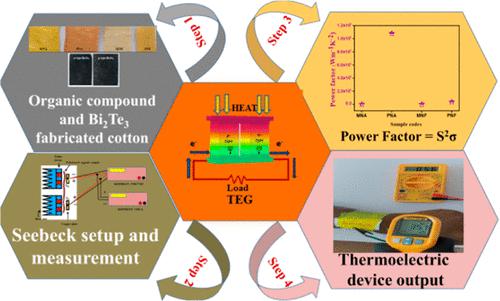当前位置:
X-MOL 学术
›
ACS Sustain. Chem. Eng.
›
论文详情
Our official English website, www.x-mol.net, welcomes your
feedback! (Note: you will need to create a separate account there.)
New Thermoelectric Material and Devices: Naphthol[1,3]oxazine and the Performance Compared with Bismuth Telluride
ACS Sustainable Chemistry & Engineering ( IF 7.1 ) Pub Date : 2023-12-28 , DOI: 10.1021/acssuschemeng.3c07082 Manikandan Subramani 1 , Sivakami Mohandos 1 , Hiroya Ikeda 2 , Lakshmi Prabha Chandrasekar 1 , BharaniDharan Sethuraman 1 , Pandiyarasan Veluswamy 2, 3 , K. Hemkumar 4
ACS Sustainable Chemistry & Engineering ( IF 7.1 ) Pub Date : 2023-12-28 , DOI: 10.1021/acssuschemeng.3c07082 Manikandan Subramani 1 , Sivakami Mohandos 1 , Hiroya Ikeda 2 , Lakshmi Prabha Chandrasekar 1 , BharaniDharan Sethuraman 1 , Pandiyarasan Veluswamy 2, 3 , K. Hemkumar 4
Affiliation

|
Herein, we have developed a state-of-the-art approach toward an organic thermoelectric (OTE) device by synthesizing oxazine monomers 2-phenyl-2,3-dihydro-1H-naphtho[1,2-e][1,3]oxazine (MNA) and 2-(furan-2-ylmethyl)-2,3-dihydro-1H-naphthol[1,2-e][1,3]oxazine (MNF) which were further developed into their ring-opening polymers (PNA and PNF) and found to exhibit the same carrier charges as that of their corresponding monomers. The synthesized organic monomer and polymers have shown significant influence through fabrication to the thermoelectric device by a parallel leg made of synthesized PANi-FeCl3/PAN p-type and n-type doped bismuth telluride (Bi2Te3) composites and produced the attracting thermoelectric output. The striking hint is that the monomer shows high resistivity and low mobility. In contrast, after the ring-opening polymerization, it demands the attractive notice of the poly naphthoxazine for thermoelectric studies. This novel approach ensures the route to produce a substantial average Seebeck coefficient of 646.70 μV K–1 and power factor 10 × 105 W m–1 K–2 and it was revealed that polymer PNA had a greater affinity toward OTE. Further, the p-type and n-type device fabrication of the monomer and the polymer was made using the p-type and n-type doped Bi2Te3, where the p-type PNA shows the highest output of 5.6 mV with PANi-FeCl3/PAN n-type doped Bi2Te3.
中文翻译:

新型热电材料与器件:萘酚[1,3]恶嗪及其与碲化铋的性能比较
在此,我们通过合成恶嗪单体2-苯基-2,3-二氢-1 H-萘并[1,2- e ][1,开发了一种最先进的有机热电(OTE)器件方法, 3]恶嗪(MNA)和2-(呋喃-2-基甲基)-2,3-二氢-1H-萘酚[1,2- e ][1,3]恶嗪(MNF)进一步发展成它们的环开放聚合物(PNA 和 PNF),并发现其具有与其相应单体相同的载流子电荷。合成的有机单体和聚合物通过由合成的 PANi-FeCl 3 /PAN p 型和 n 型掺杂碲化铋 (Bi 2 Te 3 ) 复合材料制成的平行腿制造热电器件,显示出显着的影响,并产生了吸引人的性能。热电输出。引人注目的提示是单体表现出高电阻率和低迁移率。相比之下,开环聚合后,聚萘嗪在热电研究中引起了人们的关注。这种新颖的方法确保了产生 646.70 μV K –1的平均塞贝克系数和 10 × 10 5 W m –1 K –2功率因数的途径,并且表明聚合物 PNA 对 OTE 具有更大的亲和力。此外,单体和聚合物的p型和n型器件制造是使用p型和n型掺杂Bi 2 Te 3制成的,其中p型PNA在PANi中显示出5.6 mV的最高输出-FeCl 3 /PAN n型掺杂Bi 2 Te 3。
更新日期:2023-12-28
中文翻译:

新型热电材料与器件:萘酚[1,3]恶嗪及其与碲化铋的性能比较
在此,我们通过合成恶嗪单体2-苯基-2,3-二氢-1 H-萘并[1,2- e ][1,开发了一种最先进的有机热电(OTE)器件方法, 3]恶嗪(MNA)和2-(呋喃-2-基甲基)-2,3-二氢-1H-萘酚[1,2- e ][1,3]恶嗪(MNF)进一步发展成它们的环开放聚合物(PNA 和 PNF),并发现其具有与其相应单体相同的载流子电荷。合成的有机单体和聚合物通过由合成的 PANi-FeCl 3 /PAN p 型和 n 型掺杂碲化铋 (Bi 2 Te 3 ) 复合材料制成的平行腿制造热电器件,显示出显着的影响,并产生了吸引人的性能。热电输出。引人注目的提示是单体表现出高电阻率和低迁移率。相比之下,开环聚合后,聚萘嗪在热电研究中引起了人们的关注。这种新颖的方法确保了产生 646.70 μV K –1的平均塞贝克系数和 10 × 10 5 W m –1 K –2功率因数的途径,并且表明聚合物 PNA 对 OTE 具有更大的亲和力。此外,单体和聚合物的p型和n型器件制造是使用p型和n型掺杂Bi 2 Te 3制成的,其中p型PNA在PANi中显示出5.6 mV的最高输出-FeCl 3 /PAN n型掺杂Bi 2 Te 3。





















































 京公网安备 11010802027423号
京公网安备 11010802027423号